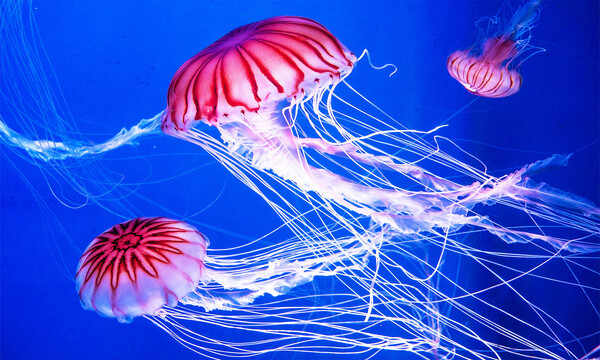Jellyfish are fascinating creatures of the ocean, known for their gelatinous bodies and graceful, undulating movements. However, many people are often puzzled about whether jellyfish are actually classified as fish. In this article, we’ll explore the question, “Are jellyfish fish?” in detail, breaking down their biological characteristics, classification, and how they differ from true fish. Let’s dive into this watery mystery!
Jellyfish are aquarium/52-marine-animals.html">marine animals that belong to the phylum Cnidaria. They are part of a larger group of organisms that also includes corals, sea anemones, and hydras. Unlike fish, which are vertebrates, jellyfish are invertebrates, meaning they lack a backbone.
Jellyfish are primarily composed of water, with soft, translucent bodies that resemble an umbrella or bell. These creatures are known for their unique movement, as they propel themselves through the water by contracting their bell and expelling water to push themselves forward.

While jellyfish and fish share the same aquatic environment, there are several key differences between them. Let’s take a closer look at these differences to help answer the question, “Are jellyfish fish?”
One of the main reasons jellyfish are not considered fish is their classification. Fish belong to the phylum Chordata, which includes vertebrates like humans, birds, and mammals. Chordates have a backbone or spine, and most have a more complex internal structure.
Jellyfish, on the other hand, belong to the phylum Cnidaria, which is an entirely different biological group. They do not have a backbone, a brain, or a central nervous system. Instead, jellyfish have a simple nerve net, a decentralized system that helps coordinate their movements.
Fish and jellyfish have very different body structures:
Fish: Fish have a well-defined body structure, including a head, body, and tail, along with fins, gills, and scales. Most fish also have a backbone made of vertebrae and a central nervous system.
Jellyfish: Jellyfish are mostly made up of a soft, gelatinous substance that is about 95% water. Their bodies consist of two layers of cells, with a thin layer of mesoglea (a jelly-like substance) in between. They do not have a heart, a brain, or complex organs. Instead, they rely on their simple body structure and nerve net to function.
Another big difference between jellyfish and fish is how they move through the water:
Fish: Fish are active swimmers and move by using their muscles to push against the water with their fins and tails. They can swim forward, backward, and even hover in place.
Jellyfish: Jellyfish use a very different method of movement. They move by contracting their bell-shaped body to expel water, which propels them forward. This form of movement is called “jet propulsion.” Jellyfish have limited control over their direction and are often carried by ocean currents.
Fish: Fish breathe by using gills to extract oxygen from the water. Their circulatory system is closed, meaning blood is pumped through vessels to supply oxygen and nutrients to their organs.
Jellyfish: Jellyfish do not have gills or a heart. Instead, they absorb oxygen directly through their skin (or epidermis). Their circulatory system is not as advanced as fish, and they rely on diffusion to distribute nutrients and oxygen throughout their body.
Fish: Fish have a complex central nervous system, including a brain and spinal cord. They are capable of processing sensory information and coordinating more advanced behaviors.
Jellyfish: Jellyfish, by contrast, have a very simple nervous system called a nerve net. This decentralized system allows them to react to stimuli like touch or light, but they lack the ability to process complex information like fish or other higher animals.
Fish and jellyfish also differ in how they reproduce:
Fish: Most fish reproduce sexually, with males and females releasing eggs and sperm into the water for fertilization. Some species give birth to live young, while others lay eggs.
Jellyfish: Jellyfish have a fascinating and complex life cycle. They go through both a sexual and asexual phase. In the sexual phase, jellyfish release sperm and eggs into the water, which form larvae. In the asexual phase, they develop into polyps and then bud off into adult jellyfish (medusa form) through a process called budding.
Despite their differences, the term “jellyfish” is often misleading, as it suggests that jellyfish are a type of fish. This confusion likely arises because jellyfish are often seen swimming in the same environments as fish, and their name includes “fish.” Additionally, jellyfish do share some basic characteristics with fish, such as their aquatic lifestyle and their ability to move through water.
While jellyfish are not fish, some species can pose a danger to humans. Jellyfish have specialized cells called cnidocytes that contain nematocysts, tiny harpoon-like structures that can inject venom into potential threats. Some jellyfish stings can cause painful reactions, while others, such as the box jellyfish, can be deadly.
No, jellyfish are not fish. They belong to a completely different group of animals known as Cnidaria, and they have distinct biological characteristics that set them apart from true fish. Jellyfish are fascinating in their own right, with unique features and behaviors that make them one of the most interesting creatures in the ocean.
While the name “jellyfish” may cause confusion, understanding the differences in classification, anatomy, and behavior helps clarify why jellyfish are not considered fish. Next time you see a jellyfish floating gracefully in the water, you’ll have a better understanding of this ancient, mysterious marine animal!
animal tags: Jellyfish
We created this article in conjunction with AI technology, then made sure it was fact-checked and edited by a Animals Top editor.